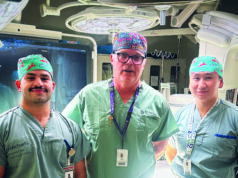
One of my earliest clinical experiences with vascular disease was as a high school student shadowing at a busy urban hospital in Detroit. A Black man with a longstanding history of diabetes developed a foot ulcer that ultimately required an amputation. Though I did not know the exact circumstances that led to his amputation, I would later learn about the cumulative insults that not only impacted his health, but also other members of the community.
The problem at a glance
Disparities in peripheral arterial disease (PAD) care and vascular surgery outcomes persist despite improvements in technology and interventional therapies. Blacks, Hispanics and Native Americans have higher rates of PAD, and undergo amputation at two-to-four times the rate of White patients. They are less likely to undergo revascularization prior to amputation, and have higher rates of morbidity and mortality after amputation and revascularization. Female patients with symptomatic PAD report greater functional impairment and worse outcomes after revascularization compared with male patients. Those patients belonging to lower socioeconomic backgrounds experience a higher burden of disease, higher risk for PAD-related hospitalizations, and higher odds of amputation in the setting of severe PAD. Patients living in rural areas face unique challenges due to physical barriers to access to care, or lack of geographic availability of specialty care. Fortunately, through decades of work we have transitioned from viewing these adverse outcomes as intrinsic failures of the patient, to considering the barriers across the PAD care continuum.
PAD pipeline
I have conceptualized PAD care—albeit simplified—as starting with patient evaluation, PAD detection and medical management initiation. For those whose disease has progressed, interface with an interventionalist may become necessary. This pathway is the PAD pipeline. However, whether a person reaches this pipeline, and ultimately moves through, it is not equal. It is influenced by structural inequities. As an example, through historical policies, geographic segregation may limit the hospitals to which a person has access, where quality may be lower. Provider biases may serve as gatekeepers limiting access to care. Patient risk factors and comorbidity burden may be influenced by disparities in education and their built environment. As Joshua Beckman, MD, has proclaimed, “PAD is the disparity,” thus mitigating the development of PAD would be most ideal. However, for those that siphon through the pipeline, it should at least be optimized.
Altering the tide
Addressing disparities in PAD care and surgical outcomes will not occur overnight, and will require a movement toward focusing on health equity utilizing a multi-pronged approach. There is no one-size-fits-all intervention. The needs of local and regional communities differ, and thus innovative and successful solutions will take that into consideration. There are several ways we can try to alter the tide:
- Recognizing the disparities in PAD burden and outcomes are the result of structural inequities. By advocating for and supporting policies that promote equity broadly—but especially those targeted toward improving access to quality healthcare—we are likely to have the greatest impact and break the generational cycle of poor health.
- At the health system level, we need to develop both intra- and inter-specialty collaboration. Patients with PAD have complex social and medical needs, and, as such, numerous specialists are involved in managing their care. Improved interdisciplinary collaboration paves the way for enhanced risk factor modification, continuity of care and ensures patients receive high-quality care most aligned with their goals. The “toe and flow” model of care demonstrates the benefits of a collaborative team approach in dealing with patients with chronic limb threatening ischemia (CLTI). Collaboration should also include other health systems. The state of Michigan is rich with collaborative quality initiatives that really seeks to share strategies to improve the quality of care we deliver across the board.
- Because health is largely shaped by the social determinants of health, developing and fostering intentional and mutually beneficial community partnerships serves to build trust among communities that have faced discrimination and abuse by the medical community. By having a finger on the pulse of the community’s needs, partnerships can help to connect individuals with healthcare providers. For example, Michigan Medicine is developing an initiative called MSHIELD geared toward addressing the social determinants of health.
- When conducting research, we should generate evidence and examine data through the lens of intersectionality, cultural humility, and acknowledge the research process itself can be biased. We should also actively support efforts to engage, recruit and retain participants from historically excluded and exploited populations. This may require diversifying the research team or partnering with trusted organizations.
- On the clinical front, we need to continue to educate ourselves about the structural inequities and its implication on patient health. We must ensure we are utilizing evidence-based medicine in a culturally sensitive manner to better provide patient centered care.
As a vascular surgery trainee, it is easy to think that vascular surgery is at the end of the PAD pipeline and all the “damage” is done. However, I would argue we have a unique perspective because of the longitudinal care we provide, and we too often bear witness to the devastating effects of progressive PAD. We have insight into problems that arise in routine practice that create gaps between evidence-based care and actual care. By capitalizing on these spheres of influence, vascular surgeons can bridge and accelerate the link between research, community, advocacy, and clinical care in a way that is most relevant and beneficial to patients and vascular surgical practice.
Chloé Powell, MD, is a 5th-year resident in the integrated vascular surgery residency program at the University of Michigan in Ann Arbor.












